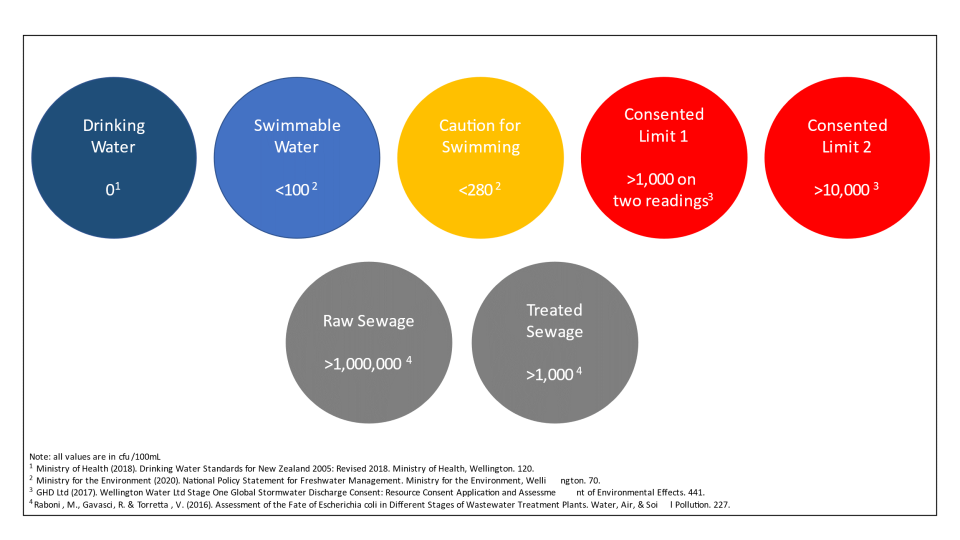Karori catchment sampling
The headwaters of the Karori Stream are in the western hillslopes of Wellington in the suburb of Karori. The stream flows south west through heavily vegetated hills and valleys before flowing out to the south coast. The stream network in the catchment is approximately 33km in length. The Karori Stream catchment was heavily forested before settlement occurred. Development has been undertaken over time, with the catchment now containing residential development at the headwaters, and a mixture of forested and agricultural land in the middle and lower reaches.
The stream is graded as Wai Kino, contaminated by human waste in the Te Oranga Wai Mana Whenua assessment framework (2021). The Te Whaitua te Whanganui-a-Tara Implementation Programme (2021) has ranked numerous water quality indicators within the Wellington urban catchment, which contains the Karori catchment, from A though to E. The Wellington Urban sub-catchment has been graded an E for E.coli, D for Copper, B for Zinc, and D and B for clarity and deposited sediment respectively. These values indicate the largest contributing factors to the decreased water quality in this catchment is currently E.coli, copper concentration, and clarity. Although it is important to note that these values are for the whole Wellington Urban sub-catchment, therefore they may be marginally different within the Karori Stream catchment.
Karori Network Improvement Review
The Karori Network Improvement Review has been completed, which looked into the effectiveness of work done in the northern and western slopes of Karori (known as the 18-south catchment') in between 2018-2022 to reduce wastewater overflows into the Karori stream.
The review report is available to view here.
Western Wastewater Treatment Plant
Map Legend
Loading
Water quality routine sample testing - how it's reported
We take regular samples of water quality to look into the level of E.Coli for freshwater and Enterococci for marine waters, which indicate whether the water is safe for swimming and other recreational activities.
The way in which we test and classify when water is safe, or not safe depends on how the stream or waterway is classified (i.e. either as a ‘consented stormwater discharge’, or a Marine and Freshwater recreational area). Find out more about our reporting requirements below:
Consented stormwater discharge
The Karori Stream is a freshwater watercourse that is covered under a resource consent approved by the Greater Wellington Regional Council (GWRC) for stormwater discharge.
The consent requires us to monitor stream water quality on a monthly basis at Friend St and at the Campbell St Bridge. The consent also requires us to undertake an investigation if the routine E.coli monitoring at either of these sites identifies a single result >10,000cfu/100mL or two successive monthly E.coli results >1,000cfu/100mL. These investigations are only initiated if the sample was not influenced by rainfall, which is cross checked with the rain gauge at Samuel Marsden School
Marine and Freshwater Recreational Areas
The Karori Stream and its mouth are not classified as a Marine and Freshwater Recreational Areas
For areas classified as a Marine and Freshwater Recreational Areas, Enterococci sample readings equal to or less than 140 cfu/100 mL, or Equal to or less than an E.coli level of 260 cfu/100mL give a suitable for swimming classification. Where a Enterococci reading is greater than 140 / 100mL, or more than an E.coli level 260 cfu/100mL, the area is given a Caution Advised classification. Finally, where an Enterococci reading is more than 280cfu/100mL, or more than an E. coli level of 550 cfu/100 mL, it is given an unsuitable for swimming classification.
These classifications are recorded and reported by LAWA (Land, Air, Water Aotearoa) and made available through their website).
In addition to this monitoring GWRC also undertakes as part of the consent routine Rivers Water Quality and Ecological (RWQE) monitoring monthly at Makara Peak Park. There are no investigation triggers associated with this additional monitoring programme.
E.coli rule of thumb guide (In development - will be updated)

Report an issue
If you believe this relates to a specific consent, please reference that consent number
Hotline
Greater Wellington Regional Council Pollution Hotline
0800 496 734
